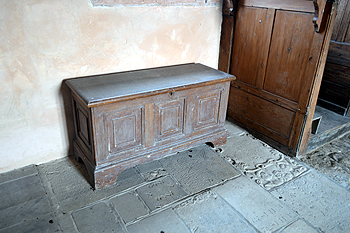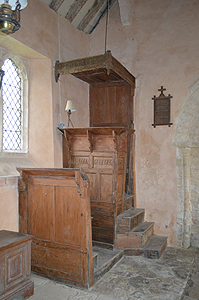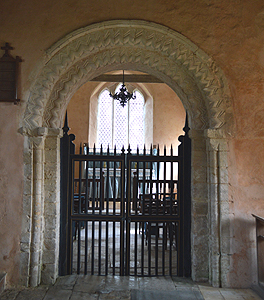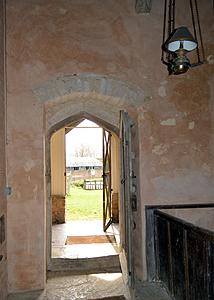List of Knotting Rectors

The parish chest March 2014
Advowson
Volume III of The Victoria County History for Bedfordshire was published in 1912. It noted that the first mention of the advowson of Knotting church is in 1176, when it was a chapelry of Melchbourne. The Bishop of Exeter arbitrated in a dispute between the Knights Hospitaller of Saint John of Jerusalem and Saint Neots convent by deciding that the chapel would continue as the convent’s property, making it entirely free of its mother church at Melchbourne. This decision was confirmed about 1190 by the Bishop of Lincoln. The convent fought off another challenge, this time from Hugh Bossard, Lord of the Manor of Knotting in 1224. By the middle of the century, however, the convent no longer held the advowson.
In 1275 another Hugh Bossard, Lord of the Manor of Knotting, was definitely patron of the living. Subsequently the lords of that manor continued to hold the advowson. Knotting and Souldrop were united as one living in 1735. The advowson of Souldrop was held by the Lord of the Manor of Souldrop but in 1792 it was sold to the Rector of the Knotting with Souldrop, Rev J W Hawksley, who also held the advowson of Knotting.
In 1801 the advowson was purchased by the Duke of Bedford, lord of the manor, who sold it with the manor to Charles Magniac of Sharnbrook in 1884. The Magniac family were still patrons of the living in 1912. The church of Knotting became redundant in 2007 and is now administered by the Churches Conservation Trust.

The font April 2015
List of Rectors
- John de Plesset: 1204;
- Walter de Wereminster [Warminster?], clerk, Rector: 1224;
- Richard de Liveto, subdeacon, vacancy through Walter de Werminster being appointed to another benefice: 1230;
- Robert de Wavetinge, subdeacon: 1230;
- Robert le Botiler;
- John de Gilling, subdeacon, on the death of Robert le Boteler: 22nd January 1277
- Robert de Bentele, acolite, on the death of John de Gidding: 3rd November 1302;
- William de Rissenden, chaplain, vacancy in that Robert de Bentele did not procure himself to be ordained priest within a year: 1st January 1303;
- Robert de Bentele, deacon, on the resignation of William de Rissenden: 2nd March 1303;
- Richard de Haregrave, deacon, on the death of Robert, brother of Robert de Haregrave, Sir Hugh Bossard , knight, had presented John Bossard, but he was rejected by the Bishop, and Hugh then presented the above: 10th April 1328;
- William de Eltesle, Rector of Abyngton, Diocese of Ely, by exchange with Richard de Hargrave: 3rd October 1332;
- Giles Lovet;
- Robert de Byllyng of Cogenhoe, priest, on the resignation of Giles Lovet: 15th August 1348;
- Richard de Tyttingtone, priest: 18 December 1348;
- John Taillour of Souldrop, priest, on resignation of Richard de Tyssington: 11th November 1351;
- John atte Mulle, priest, vacancy: 1st March 1377;
- Adam Werley, priest, on exchange with John atte Milne to Bolnhurst Rectory: 15th May 1391;
- John Turveye, on death of Adam Werle who died in the Rectory of Knotting on 4 March last: 25th March 1392;
- John Godard, priest, the on resignation of John Turveye: 20th February 1393;
- Robert Godard, priest, vacancy: 31st October 1399;
- Thomas Plukkerose, priest, on resignation of Robert Godard: 9th October 1437;
- Robert Ireland, priest, on the resignation of Thomas Pluckrose: 16th November 1461;
- Thomas Watre;
- Edmund, priest, on the death of Thomas Watre: 22nd February 1499;
- Edmund Percyvall: 1526;
- Robert Ellis, chaplain, on the death of the last incumbent: 22nd June 1545;
- John Blackwell: 21st January 1548;
- John Pyebourne: 19th February 1555;
- Robert Griffithe, clerk, on the death of the last Rector: 10th July 1560;
- Arthur Alvey: 8th October 1591;
- William Bunt, clerk: 31st July 1644;
- Robert Hawkins, clerk: 21st August 1645;
- Thomas Scrivener, clerk, on death of Robert Hawkins: 15th March 1665;
- John Sharpe AM, on the death of Thomas Scrivener: 1st April 1699;
Unification of the parishes of Knotting and Souldrop
- John Sharpe MA: 30th June 1735;
- Robert Pye LLD, clerk, on the resignation of John Sharp: 30th May 1743;
- John Bradley MA, on the cession of Robert Pye: 24th October 1770;
- Isaiah Jones BA, on the resignation of John Bradley: 24th August 1771;
- John Webster Hawksley BA, on the death of I Jones;
- George Digby Newbolt BA, Brasenose College, Oxford: 9th May 1856;
- Francis Edward Millard Girling: February 1896;
- James William Weldon Davies: April 1930;
- Harry Legg Clothier: 1955;
- Stanley Peart Hutton: 1969;
- Harold Desmond Jones: 1980;
- Roy Oswald Hubbard: 1990;
- Ian W. Arthur: 1996;
- Robert A Evens: 2005

The pulpit March 2014
Visitations
Volume 81 published by the Bedfordshire Historical Records Society (2002) is devoted to returns made during episcopal visitations to the county by the Bishop of Lincoln in the early 18th century, edited by former County Archivist Patricia Bell. It throws some interesting light on non-residency and the general state of the church in the parish. At this date it was common for a rector or vicar to not live in the parish he nominally served, often because he had more than one, and so employed a curate to undertake their parochial duties for him. The returns for Knotting are as follows:
- 1709: the Rector (John Sharpe) was priested by the Bishop of Chichester on 1st January 1695. “None Un-baptized. Severall not Confirmed. Communicants in all 42. Of these 6 only received at Easter last, so that there are too many who seldom or never receive at all”.
- 1712: “The Rector resides in his Parsonage House. None un-baptized; many not confirmed. Divine Service at present but once a day, every Lord’s day, and upon Holy days when a Congregation can be got. The other time he supplys his other Cure of Newton Bromsall com. Northampton. Communion 3 times a year. Out of between 40 and 50 communicants, not above 8 receive.”
- 1717: The Rector continued to reside in the Rectory and had no curate. Sacrament was still held three times a year with seven or eight out of forty receiving.
- 1720: Services were now held: “On Sunday twice and some Holydays only, for want of a Congregation”. Thirty were now eligible for receiving communion or whom five or six received..

Chancel gates March 2014
Ecclesiastical Census
On Sunday 30th March 1851 a census of all churches, chapels and preaching-houses of every denomination was undertaken in England and Wales. The local results were published by Bedfordshire Historical Records Society in 1975 as Volume 54, edited by D. W. Bushby. The return for Knotting church was made by the curate, Adolphus Hamilton, who noted the following pieces of information:
- The church had 50 free seats and 35 others;
- General congregation had been 35, in the afternoon.
- Sunday scholars amounted to 30.

The view from the south door March 2014